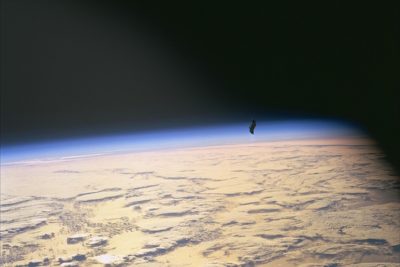Tesla Tower: The Tragic Story of Nikola Tesla’s Wardenclyffe Wireless Station
Share

Tesla Tower in 1904. (Marc Seifer Archives)
Wardenclyffe Tower (1901– 1917), otherwise called the Tesla Tower, was an ancient but novel exploratory remote transmission station that was envisioned and established by Nikola Tesla in New York between 1901 and 1902.
Tesla’s prime intent was to put on the air telephony, messages and facsimile images to England across the Atlantic Ocean and to ships adrift. This was in the light of his speculations to conduct signals utilizing the Earth.
The genesis of Tesla Tower or Wardenclyffe tower

Nikola Tesla. (Napoleon Sarony / Wikimedia Commons)
Nikola Tesla made a dramatic and triumphant entry in the twentieth century, at the zenith of his career. Through his sojourn, still, at his acme, he aspired to bring to fruition, the Tesla Tower, the behemoth of all his historic inventions.
The tower promised to be a cutting-edge universal telecommunication system. His avant-garde theory was eventually shown the go-ahead in 1901. Yet in under a year’s time, the project ran into gloom and doldrums that ultimately wrecked Tesla both scientifically and economically. What really transpired during the year?
Financing of Tesla Tower
The splendid inventions of Tesla between 1856 and 1943 had ushered in the technology of alternating current. It made supplying power and illuminating big cities conceivable.
His experimental nerve centre at the high altitudes in Colorado Springs bears testimony to his countless entrancing achievements, which he had the privilege and resources to accomplish.
Tesla returned to New York in January 1900. There, he made several rounds trying to woo investors at the Waldorf-Astoria’s Palm Garden (where he then was put up), The Players Club and Delmonico’s whilst wining and dining with them.
He initially approached friend George Westinghouse who declined to put money into the project as he had a remarkable mind for business. He, however, lent Tesla $6,000. Westinghouse advised Tesla to pursue some wealthy venture capitalists.
Tesla consequently engaged in multiple talkfests with rich investors like Thomas Fortune Ryan, John Jacob Astor, and Henry Havemeyer. However, nothing worthwhile fructified.

American banker J.P. Morgan. (Pach Brothers / LOC)
In November 1900, Tesla picked up the attention of financing mogul J. P. Morgan. Tesla seduced him to sign a contract valued at $150,000 to build and develop the wireless station of the mammoth, futuristic and stupefying Tesla Tower in March 1901.
Morgan was actually fascinated by the grand slam of Guglielmo Marconi, Tesla’s rival that sent reports from America’s Cup yacht at Long Island to New York City by dint of wireless radio. Morgan had early doubts about the viability and patent priority of Tesla’s plan.
However, through several rounds of conversations, Tesla assured and convinced Morgan about the superiority of his proposed plan and how it superseded the patent of Marconi. He asserted that his wireless project would far outsmart Marconi’s.
Construction of Tesla Tower
After acquiring Morgan’s investment, Tesla began his work immediately. He purchased a 200-acre plot in Long Island. Large electrical transformers and generators were commissioned as was needed by the Westinghouse Electric Company.
Tesla promptly employed the prominent architect Stanford White who too was taken with Tesla’s idea. Both of them took to designing a gigantic wooden tower with a height of 187 feet and a metal hemispherical dome (known as cupola) of 68 feet diameter.

Nikola Tesla’s Wardenclyffe wireless station. (Arthur B. Reeve / Tesla and his Wireless Age)
The architecture of the telecommunication station, inspired by the Italian Renaissance, housed the main premise, research laboratories and several other facilities.
In July 1901, Tesla briefed Morgan on some more prospective modifications in the project to generate an enhanced, awe-inspiring plan, a virtual quantum leap ahead of his competitors to garner significant profits. This was primarily to pick up a high ground over Marconi.
He professed that he would be able to dispatch Morse code messages transatlantic alongside simultaneously transmitting long-distance wireless electricity.
With Tesla essentially inviting a breach of contract, Morgan, point blank denied lending surplus funds. He rather demanded an explanation for the capital already expended.
Regardless of Morgan doling out no extra funds, Tesla proceeded with the venture. He broached upon the idea to build numerous smaller towers or a tower with a height range of 300 feet to 600 feet.
This would have transmitted the low-frequency waves which Tesla believed were necessary for resonance in the Earth. Then, White estimated that the proposed revamp of 600 feet would cost $450,000. The plan instantly was written off.
In September 1901, Tesla needed to commence the tower construction remaining consistent with the original plan. After two months, the project suffered another major setback.
Marconi by then had figured out how to send the alphabet “S” in Morse code over the ocean between England and Newfoundland in Canada. Tesla protested against the Italian’s alleged utilization of 17 of Tesla’s licenses.
However, finally, the prosecution supported Marconi and by that time the commercial damage was already rendered. In those times of financial vulnerability, funders preferred investing in the Marconi system, which being less resourceful had made notable progress.
Dereliction of Tesla Tower
In 1906, Tesla suffered a series of nervous breakdowns because of the mounting financial problems. He was exhibiting signs of obsessive-compulsive disorder and later became a potential high-functioning autistic.
Tesla’s chief manager, who supervised Wardenclyffe, left the job to find other employment opportunities. The neighbours around the tower found it to be deserted without any intimation.
In 1904, Tesla put the Wardenclyffe property on mortgage, for covering his staying expenses to George C. Boldt, the owner of Waldorf-Astoria Hotel. In 1908, Tesla secured another mortgage to further meet his expenses.
Around 1911, the facility was partially forsaken and the structure of the tower started disintegrating. From 1912 to 1915, Tesla’s financing details were disentangled. Much to their dismay and displeasure, when the financers enquired about the ways to recover their investments, Tesla was not able to give acceptable answers.
Demolition of Tesla Tower
Tesla’s total cumulative debt to Waldorf-Astoria was close to $20,000 by mid-1915. Because of severe negligence and financial setbacks, Tesla became completely incapacitated to make repayments for the mortgages.
It was Boldt who then decided to foreclose the Wardenclyffe property. Boldt found the property totally useless and ultimately made up his mind to demolish the tower and sell it as scraps. It was the Smiley Steel Company who began dismantling the tower by dynamite explosions on July 4, 1917.
The work was completed in the month of September and the razed tower was sold off as scrap at an estimated value of $1750. The main facility was breached and vandalized. It turned out to be a manufactory of photographic material, down to AGFA closing it in 1992.
Malicious rumour of German spies
However, in course of the World War I, a vicious rumour spread like a wildfire in most newspapers and different publications. It was conjectured that Wardenclyffe was decimated after receiving orders from the then US government.
The officials had apprehensions that German undercover agents were putting the tower to work as an observation post, a radio transmitter or as a marker for German submarines.
Tesla was highly dejected when he learnt about this rumour that questioned his layers of patriotism. But he avoided speaking out to the press and revealing the genuine reason for the demolition. This was because he kept his association with Boldt and the related accounts about the mortgage off from the public.
What happened after the dismantling?
Between 1980 and 2000, the hazardous wastes from the photographic age were cleaned up. The site was disposed of and green-lighted for a new development.
IndieGogo, a grassroots campaign by two Russian physicists, managed to succeed in purchasing and saving the property with the sole aim to build a museum in the memory of Nikola Tesla. In 2018, was site was registered as a heritage spot in the National Register of Historic Places.
Resurrection of Wardenclyffe
As per last reports from Reuters available in the records, in 2014, two Russian physicist brothers Leonid and Sergey Plekhanov started to raise funds for the revival of Tesla’s progressive project.
Subsequent to investigating Tesla’s journals and plans, the Plekhanovs believed that with the help of ultra-modern solar panels, lighter building construction materials and $800,000, they can reconstruct the Tesla Tower.
The Plekhanovs have conducted basic research and analysis, executed the computational models and composed every part of the test. They trusted that with the proposed architecture in place, they have the ability to transmit energy and measure the results.
The Plekhanovs’ exploration appraises that around 38,000 square miles construction of solar panels amid a desert close to the equator could produce adequate power to supply the world’s electricity requirements.
Tesla’s pinnacle could deliver electricity to the consumers, but the only means to accomplish this concept is to rebuild it and discover. As of the latest publication, they have successfully raised assets worth over $40,000 through crowdfunding, for the venture through the IndieGoGo kick starter campaign.
End of the line
Tesla’s ultimate wish was to generate electricity from the gigantic resources of the Power Plant adjoining the Niagara Falls and distribute all over the world. The project was sheer magnificence. But, sadly it never saw the light of the day.
Pioneering concepts of telegraph and telephone communications were spearheaded by Tesla at Long Island. They are still considered to be the bedrock of the present day’s rapidly developing advancements in the domain of wireless communications across nations and continents alike.
Had the Tesla Tower been completely constructed without any interruption, Tesla might have managed to change the pathway of history once again.
The facets of instant availability of information, power, pilfered phonograph cylinders and lascivious photographs of floozies with bare ankles might have inundated the “TeslaNet” ushering in the Information Age nearly a century ahead of its schedule.
It definitely would have made the world, in the present times, a different place to live in. Now is the time to appreciate the future that Tesla had envisaged, albeit somewhat behind the calendar.
Enjoyed this article? Also, check out “Optical Telegraph: Communication Before the Internet“.
Fact Analysis:
STSTW Media strives to deliver accurate information through careful research. However, things can go wrong. If you find the above article inaccurate or biased, please let us know at [email protected]













